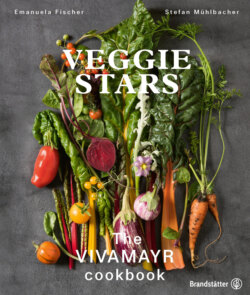Читать книгу Veggie Stars - Emanuela Fischer - Страница 11
ОглавлениеHow to make this book a lifelong companion
Fresh seasonal vegetables are the stars of VIVAMAYR cooking. In order to provide you with proper guidance, the recipe chapter starting on p. 50 presents them in accordance with the most important categories. The symbols used (see below) enable vegan and vegetarian dishes to be identified at a glance. They also highlight recipes which are easy to prepare, even for those with little experience of cooking. Special “free from” icons provide a clear labelling system which saves you the trouble of looking through lists of ingredients to check for allergens such as lactose and gluten.
Turn to the VIVAMAYR Cookery School on p. 26 ff. to discover all you need to know about dealing with oils, fats, herbs and spices. It presents detailed information on the art of using oils and fats (p. 30 ff.) and on the art of using herbs and spices (p. 34 ff.) alongside basic recipes for mixtures, sauces, doughs and toppings.
A summary of alternative products, which can also be used to prepare the dishes equally well, is provided on p. 42. This will enable you to use all of the recipes regardless of seasonal availability.
Standard utensils which can be found in any home kitchen are perfectly adequate in order to prepare the food described. For those wishing to upgrade their equipment, p. 29 showcases a number of practical professional devices and appliances which are used in the professional kitchens at the VIVAMAYR Medical Health Resort.
Labelling of the recipes
Identifying symbols have been placed against all dishes so that you can tell at a glance which recipes are suitable for which food intolerances.
| F: Fructose intolerance | |
| G: Gluten intolerance | |
| H: Histamine intolerance | |
| L: Lactose intolerance | |
| C: Candida 1 |
Recipes containing no dairy produce and vegetarian and vegan recipes are marked ndp, vegetarian and vegan respectively.
shows the amount of work involved.
Beginners
Intermediate
Challenging
Alkaline foodstuffs
Vegetables
Potatoes
Ripe fruit, ideally seasonal and home grown
Cold-pressed vegetable oils
Fresh herbs
Almonds
2/3 alkaline
Acidic foodstuffs
Animal-based proteins
– meat, fish and dairy products
Cereals and pulses
Acidic tropical fruits such as lemons, limes and pineapples
Nuts and seeds
Warm-pressed vegetable oils and animal fats
Alcohol, coffee, nicotine
Processed foods
1/3 acid
Some foods have an acidic content, but there are also others which extract alkalis from the organism when they are metabolised. These alkali predators include sugar, confectionery, products made from white flour and fizzy drinks. Neutral foodstuffs such as water, butter and millet, which are virtually acid-base balanced, form a fourth category.
